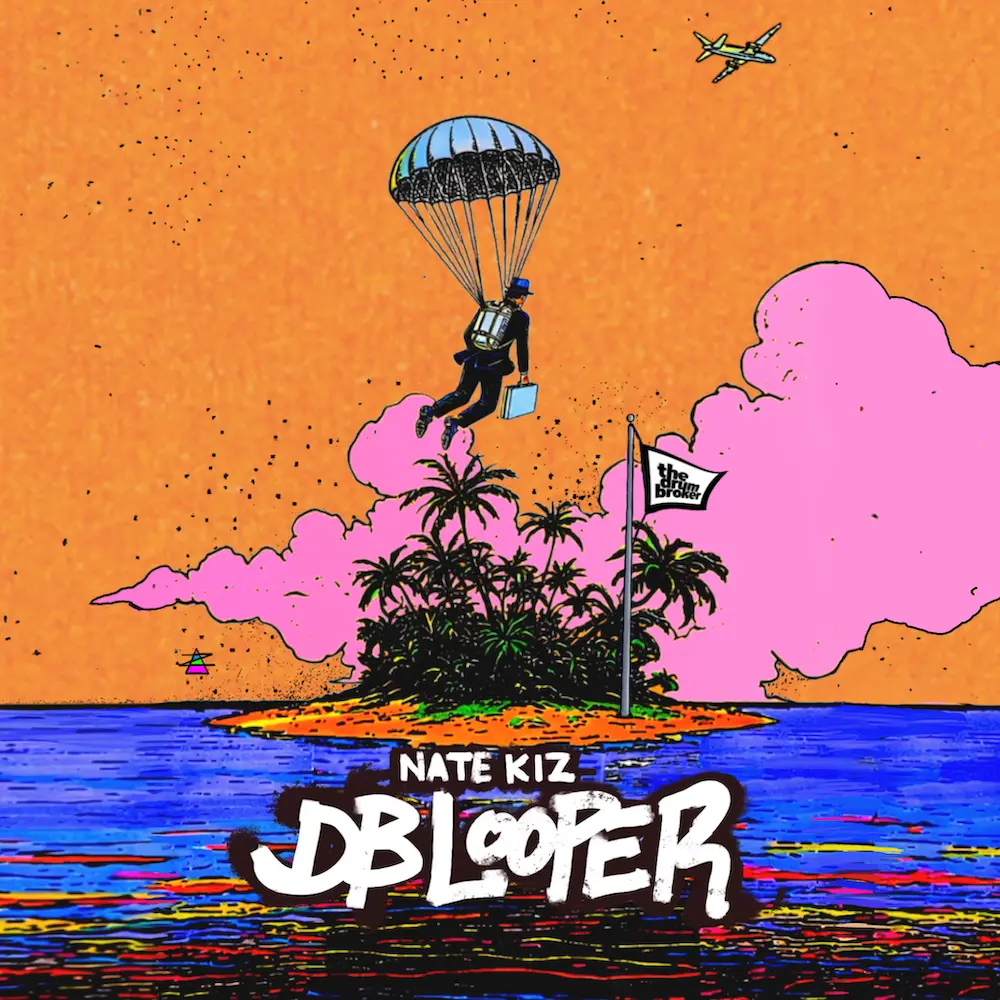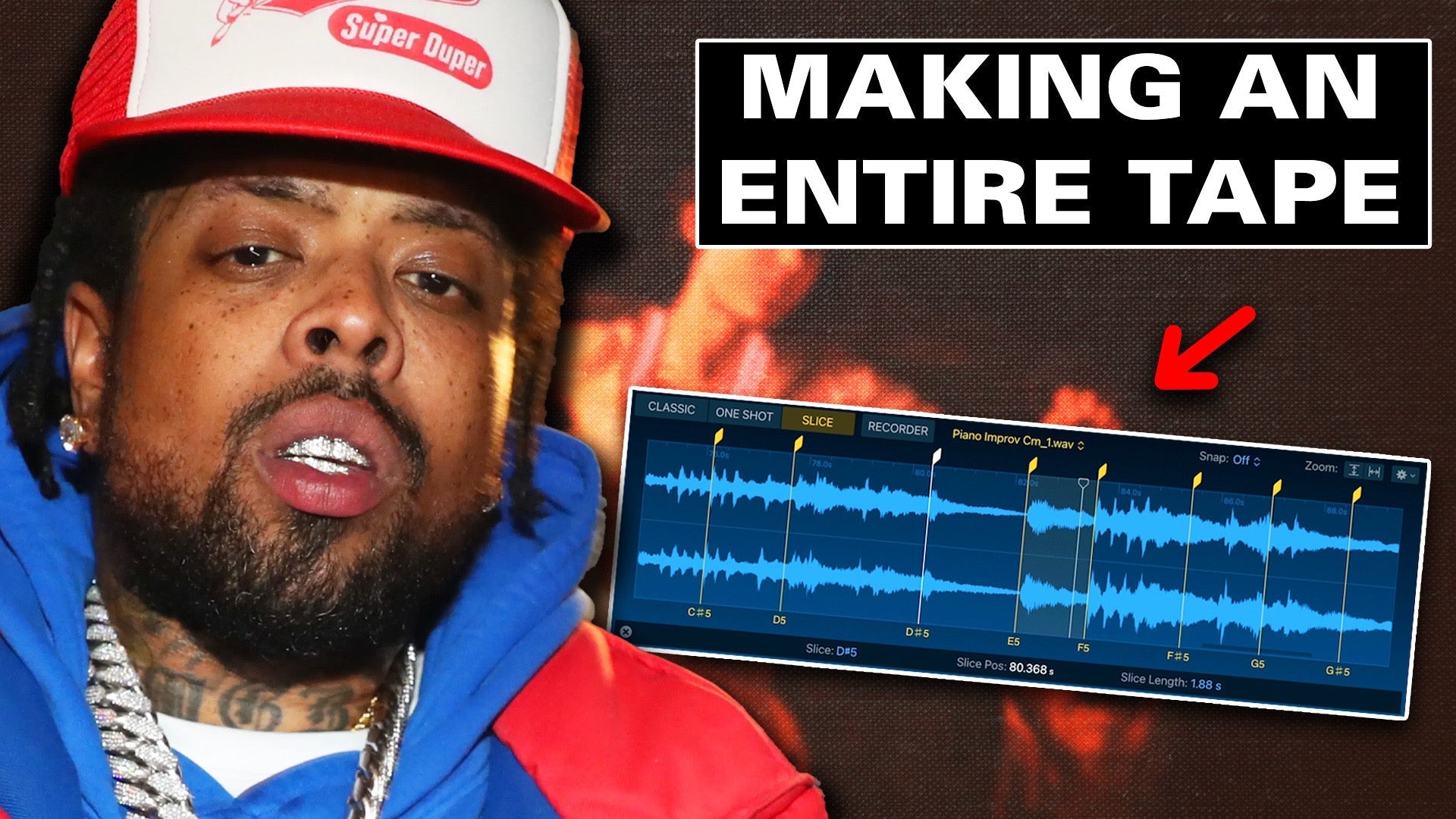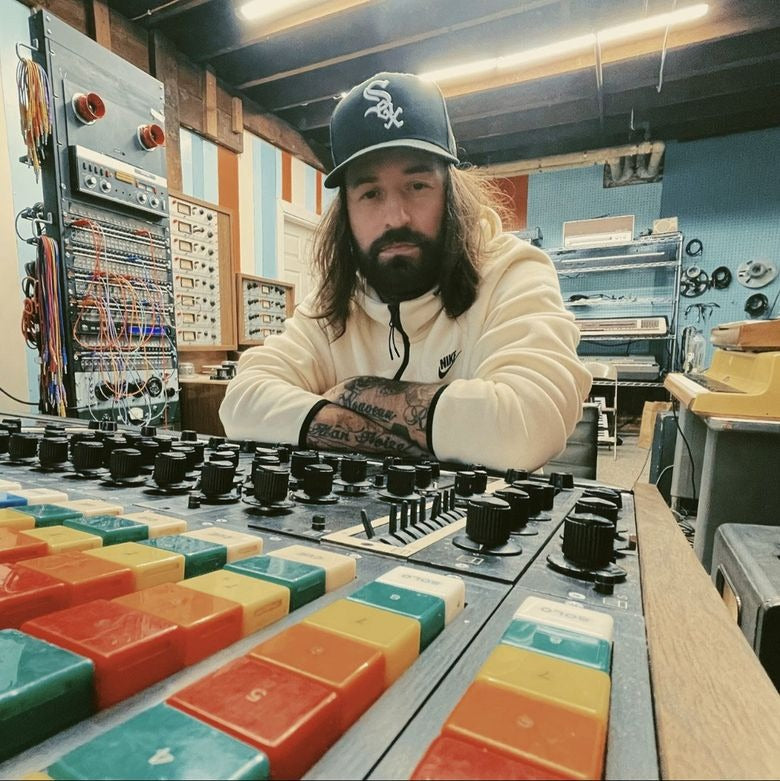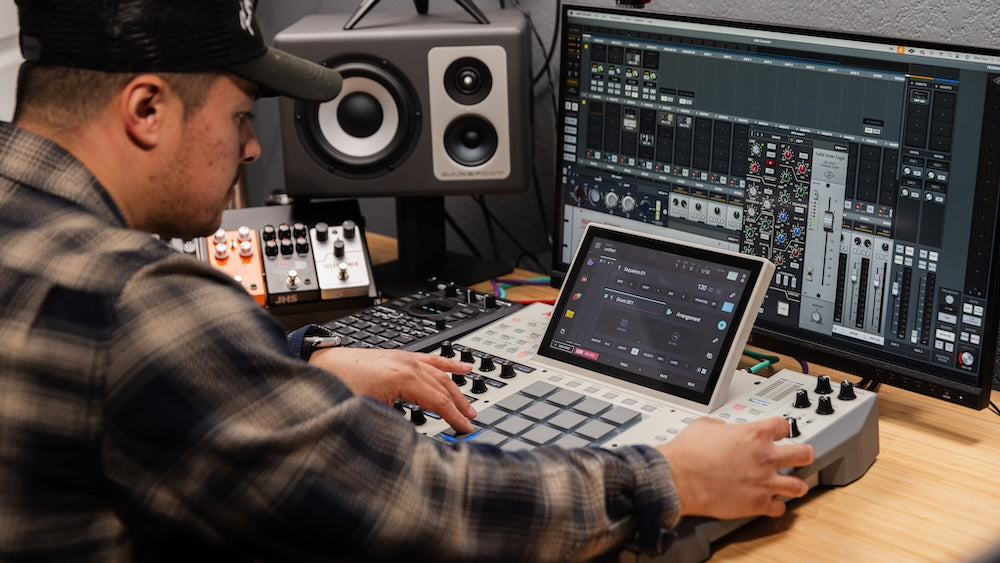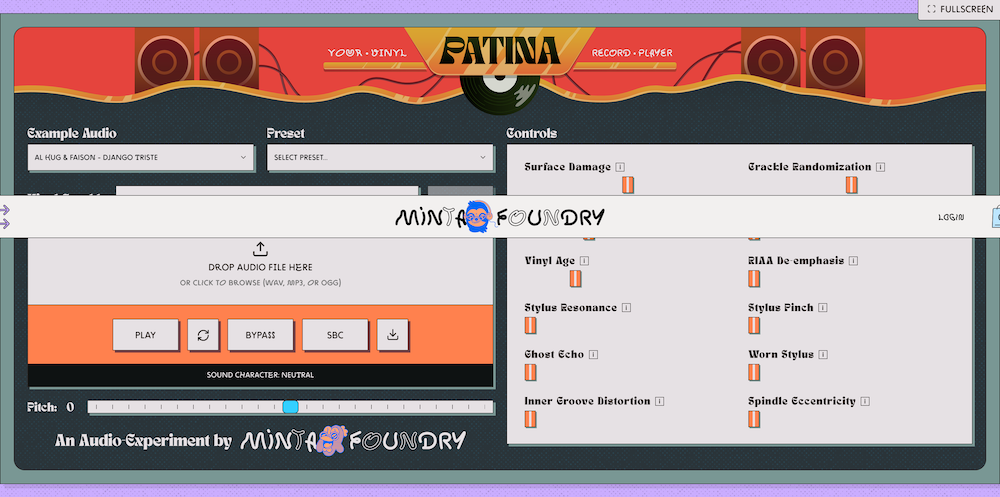Two Terabytes to DB Looper: Natekizbeats’ Creative Leap with The Drum Broker
When Nate Kiz opened the Dropbox link from The Drum Broker, he wasn’t prepared for what stared back: nearly two terabytes of drums and samples, a digital crate-digger’s dream and nightmare. To make sense of it, he worked out a simple formula for DB Looper: each beat would be built from one melodic sample and one drum sample. The catch was that those elements could never come from the same pack. That way, even if he dipped into the same pack for another beat, the drums and melodies were always sourced separately, keeping every track unique. The result was DB Looper, an album built entirely from Drum Broker sounds where Nate stepped away from his usual micro-chopped style to embrace looping. But it wasn’t just drag-and-drop. He chopped many of the drum sounds into new patterns, layering his own swing into the project so that each track carried his fingerprint. The Early Days For Nate Kiz, beatmaking started long before DB Looper ever hit Bandcamp. His dad was a drummer, so music gear was always around the house. But instead of sitting at a kit, he got curious about how rhythms could be programmed. A bootleg copy of Fruity Loops 3 gave him his first taste of digital production. Around the same time, a PlayStation music game introduced him to sequencing in a different way. Those tools weren’t glamorous, but they made him realize he’d rather build the beats than rap over them. In the pre-YouTube era, learning production was slow and hands-on. Every problem meant trial and error: figuring out why samples didn’t line up, how to clean up muddy sounds, or how to make drums knock harder. “Everything took longer back then,” he says, “but those mistakes gave my beats a grit I still chase today.” Koala Sampler Eventually, he embraced new tools like Koala Sampler on iPad, drawn in part by learning that Madlib made beats entirely on his tablet. At first, he doubted a $5 app could compete with heavyweight DAWs. Now, nearly 1,000 Koala beats later, it’s his main weapon. “Koala lets me work anywhere: on the couch, in the car, even waiting in a parking lot,” he says. “It’s pure focus with zero bloat.” Flipping the Packs When the Drum Broker drop arrived, Nate Kiz went straight for trusted names: • The Alchemist - Break Fluid and Soundbytes • Beat Butcha - Filth Series • Jake One - Snare Jordan • Marco Polo - Signature drum kits • Select gems from Soul Surplus and Kingsway Music "I wanted each beat to feel unique, so even if I pulled from the same pack twice, I never took both the drums and melody from it on the same beat. The drums always came from a different source, or vice versa. That way, each track still had its own DNA,” he explains. “Once I picked my melodic loop and drums, I’d just start building. No second-guessing." The Concept The name DB Looper wasn’t just a clever play on “loops.” It carried a story. Nate explained that he always liked the mystery of DB Cooper, the infamous hijacker who vanished in the 1970s after parachuting from a plane with stolen cash. For his project, he flipped that myth into a producer’s tale: DB Looper is a character who breaks into The Drum Broker vault, steals two terabytes of samples, and disappears into hiding. On the album, that story plays out in beats, skits, and visuals. Each track is like another page in the caper, with the character escaping the scene, finding refuge on an island, and building a new identity out of the sounds he stole. “I wanted it to feel like you’re following this character’s journey, not just listening to a beat tape,” Nate said. This narrative twist gave the project its identity. The “DB” in DB Looper became both Drum Broker and a nod to DB Cooper, while the “Looper” highlighted Nate’s decision to embrace loops over his usual micro-chopped approach. It’s more than just a project name: it’s a concept album built on myth, creativity, and the fun of reimagining history through hip hop production. For Nate, DB Looper wasn’t just about beats or loops. The story gave him a canvas to experiment with visuals, skits, and animation that carried the project further. More Than Music, A Story in Loops DB Looper isn’t just an audio project, it’s a multimedia concept. Nate Kiz expanded the world with storytelling, voice acting, and animation, giving the release a distinct visual identity. His growing animation skills fed into skits, promo videos, and stickers, and he’s experimenting with collaborations to keep pushing boundaries. “I don’t just want people to hear this project,” he says. “I want them to step into its world.” Why Koala Sampler Koala’s simplicity and portability made DB Looper possible in ways no other setup could. The app strips beatmaking down to essentials which include sampling, chopping, sequencing without the clutter of a full DAW. But that minimalism comes with quirks. Sequencing can be tedious, and without traditional quantization, mistakes sneak in. Instead of fighting them, he leaned in. The swing and off-kilter feel became part of the project’s character, making the loops feel alive. To expand Koala’s sonic palette, he paired it with the AUM app, running loops through effects chains that added grit, texture, and depth. This workflow let him blur the line between lo-fi and polished. Nate also relied heavily on BABY Audio’s FX Plugins as well as FabFilter’s Limiter for the project, which helped him polish the mixes. The biggest shift, though, was freedom. Koala let him make beats anywhere: sketching on the couch, finishing chops in the car, even sneaking in a loop while his child napped. “Sometimes I only have 15 minutes,” he says. “But with Koala, I can get an idea out before it disappears.” Goals Beyond DB Looper Looking forward, Nate Kiz aims to release four projects a year, whether solo beat tapes, full collaborations with rappers, or producer-to-producer joint efforts. He’s also working toward launching his first sample pack, built from field recordings, contact mic experiments, drum loops, and melodies crafted with boutique gadgets. His ambition isn’t about chasing placements, it’s about creating complete, self-contained works that reflect his vision. Hear the Project for yourself: DB LOOPER on bandcampDB LOOPER on SpotifyDB LOOPER on Apple Music Follow Nate Kiz on Instagram: @Natekizbeats
Watch Oscar Zulu Flip Original Soul Samples Into A Griselda-Style EP (Beat Breakdown)
In this video, Oscar Zulu breaks down his full creative process for crafting a Griselda-style EP from scratch—using only one sample pack: Mahogany Segments Vol. 2. From dirty drum breaks and soul samples to gritty basslines and haunting vocals, Oscar takes you inside the studio to show how he built 5 skeleton beats inspired by Westside Gunn, Conway the Machine, Benny the Butcher, Stove God Cooks, and other legends of underground coke rap. Featuring samples reminiscent of The Alchemist, Daringer, and Knxwledge, this pack is a goldmine for fans of that luxurious grime sound. Perfect for producers aiming for that Griselda, Boldy James, or Freddie Gibbs vibe. Download the Sample Pack Here: Square One Shots - Mahogany Segments Vol. 2
Mario Luciano's Polyphonic Music Library: The Vintage Samples Behind Drake, Kendrick, and J. Cole Hits
Mario Luciano: The Analog Soul Behind Today's Biggest Hits How a Seattle producer's vintage-inspired sample library ended up on tracks by Drake, Kendrick Lamar, and more The Vinyl Alchemist When Drake's "8AM in Charlotte" dropped in 2023, music fans worldwide heard something hauntingly familiar yet impossible to place - a soulful, crackling gospel sample that sounded ripped from a dusty 1970s vinyl. But this wasn't some obscure record store find. The sample came from Mario Luciano's Polyphonic Music Library (PML), a boutique collection of new recordings meticulously crafted to sound decades old. "I wanted to bring back the authenticity of 60s and 70s recordings," explains Luciano, the Seattle-based producer whose vintage-inspired creations have quietly infiltrated hip-hop's biggest releases since 2019. From Bedroom Producer to Grammy Credits Luciano's journey began with an obsession. Growing up immersed in the warm textures of church gospel, vintage soul, and psychedelic jazz, he became fixated on a question: how exactly did those old records sound so alive? Instead of relying on digital plugins like most of his peers, Luciano dove headfirst into old-school methodology: Recording to analog tape Using period-correct instruments and amplifiers Embracing imperfections that give vintage recordings character Studying the recording techniques of different eras and regions This obsessive commitment paid off. By his late twenties, Luciano had earned co-production credits with prominent names, including a placement on H.E.R.'s hit single "Slide" (2019) and even a Grammy nomination for his contributions to other projects. The Library That Bridged Decades In late 2019, frustrated by generic sample packs flooding the market, Luciano launched the Polyphonic Music Library as a passion project. His mission was simple but ambitious: produce new music that sounds genuinely old. The PML quickly gained industry attention through releases like: Mario Luciano Vol.1 - Original compositions and analog drum breaks Soul Expressions - Lush 70s soul-inspired grooves Cinema Themes - Dramatic soundtrack-style compositions Regional collections like Italia, Brasil, and Japan Within just two years, this one-man operation had placed samples on tracks by an impressive roster: Drake, Kendrick Lamar, J. Cole, Madlib, Jack Harlow, Westside Gunn, and Conway the Machine. Inside the Analog Laboratory What sets the Polyphonic Music Library apart is Luciano's painstaking production process. Each composition begins with live instruments: "I'll start with melodies on a vintage keyboard or Moog One synthesizer, then layer real horns, flutes, strings, Hammond B3 organ, guitars... capturing everything through ribbon microphones and tube compressors to get that warm room sound." Every step favors authenticity over convenience. Luciano processes sounds through: RCA BX-44 ribbon microphones Teletronix LA-2A tube compressors Roland Space Echo tape delays Vintage Fender Vibrosonic amplifiers The results often include intentional "aging" - subtle tape hiss, vinyl crackle, or looser timing on drum fills - all serving the illusion of a discovered record rather than a new creation. From Library to Billboard The library's influence reached new heights when: Drake built "8AM in Charlotte" (2023) around a haunting Polyphonic gospel-soul sample Kendrick Lamar tapped Luciano's work for "Savior" from his Grammy-winning album J. Cole's "p u n c h i n' . t h e . c l o c k" (2021) featured a soulful Luciano co-production Jack Harlow gave "Is That Ight?" (2023) a distinctly old-school foundation Even sampling legend Madlib recognized Luciano's talent, inviting him to contribute "Shades of Mauve" to the Madlib Invazion Music Library Series in 2024 - a collaborative album with vocalist Lauren Santi released on limited edition vinyl. A Musical Time Machine PML's catalog traverses multiple genres while maintaining its vintage authenticity: Gospel and Soul: Church choirs and uplifting brass sections Jazz and Funk: Modal explorations and electric grooves Psychedelic Rock: Wailing guitars and spacey, tape-warped effects Cinematic Soundscapes: Dramatic orchestral arrangements Regional Genres: Italian library music, Brazilian bossa nova, French yé-yé The Analog Renaissance Luciano's success represents a cultural shift in music production. In an era when technology allows producers to create entirely "in the box," his work reasserts the value of analog processes and live performance. Egon (Eothen Alapatt), the respected curator behind Madlib Invazion, praised Luciano's work as having "shades of the coolest French library albums of the 70s" - positioning PML in the lineage of classic library records now considered cultural artifacts. As sampling continues to drive popular music, Mario Luciano ensures that today's charts remain connected to analog traditions. Through the Polyphonic Music Library, he's created a feedback loop where past and present harmonize - preserving musical traditions by reimagining them for today's producers. Listen to the Polyphonic Music Library
From Pandemic Garage to Global Inspiration: The Rise of Hip-Hop’s Malo
Stuck in a garage during the pandemic, hip-hop beatmaker Malo reignited his passion for vinyl sampling and transformed it into a thriving online community. Explore how an undying love for gritty loops, classic MPC workflows, and honest storytelling turned a moment of crisis into a worldwide musical inspiration.
Patina – Free Vinyl Simulator: Bring Authentic Record Warmth to Your Digital Tracks
Patina: The Free Browser-Based Vinyl Record Simulator Digital audio is pristine and precise—yet there’s something magical about the warmth and character of vinyl. Patina, created by Al Hug and Faison of Minta Foundry, blends those old-school imperfections with modern convenience by running entirely in your browser. It’s free, it’s authentic, and it’s ready to inject a timeless vibe into your tracks. The Beauty of Vinyl Imperfections Vinyl carries a certain life that digital formats often miss. Each record is shaped by real-world physics: the grooves, the gentle compression from the needle, and the scratches acquired over time. These so-called “flaws” are actually what make vinyl special. The gentle crackle, the wear on the grooves, the subtle wow and flutter—together, they produce a sound that feels immediately familiar and alive. Patina recreates these qualities so convincingly, you’ll swear you’re listening to a dusty LP spinning on a vintage turntable. How Patina Captures the Vinyl Experience Patina isn’t just adding random noise on top of your audio. Every effect is carefully modeled to respond dynamically, creating an ever-evolving sonic texture that mirrors how a real record wears and warps over time. Needle noise, spindle eccentricity, and even the classic RIAA curve have all been integrated. This ensures that everything from the initial crackle to the final fade-out replicates the true character of vinyl playback—no hardware required. More Than Just a Web Tool One of the biggest draws of Patina is its ease of use: simply drag, drop, and tweak right in your browser. But the vision doesn’t stop there. The team behind Patina understands that professional producers and sound designers often work within DAWs. That’s why they’re considering a plug-in version, allowing you to seamlessly integrate vinyl textures into your workflow without ever leaving your production environment. The Depth of Patina’s Emulation Vinyl’s natural wear and tear is captured across multiple dimensions in Patina. The Vinyl Texture Engine covers everything from pristine, barely touched grooves to decades-old static and crackle. The Warp & Deterioration Module handles subtle pitch fluctuations, and the Stylus & Groove Damage Simulation reproduces the compression and harmonic coloration you’d get from a needle that’s been around the block. There’s also Realistic RIAA EQ Filtering to shape the frequency response, while dropout and pitch modulation controls let you fine-tune the quirks of a turntable that’s seen a few too many spins. For those who want an even rawer feel, Pinch Distortion & Worn Stylus Effects can add extra grit and character. The Mastering Stage: A Final Touch of Authenticity Patina goes beyond simple vinyl artifacts by offering a Mastering Stage Selection, replicating the final step in the record-making process. You can choose a neutral chain or evoke iconic mastering styles—from the punchy warmth of Motown to the polished depth of Abbey Road. Each profile lends its own distinct personality, letting you sculpt exactly the vibe you want. Whether you want a velvety jazz aesthetic or the raw grit of an old-school hip-hop pressing, this feature puts the final sonic signature in your hands. Looking Ahead Because Patina’s sonic range fits so many genres—from lo-fi beats to cinematic soundscapes—you can explore new textures and nostalgia-tinged tones with minimal effort. Producers looking for that authentic drum-break vibe, or sound designers seeking an analog flourish, will find Patina invaluable. And with a DAW-compatible version in development, integrating these vinyl touches directly into your workflow will soon be even easier. Fire It Up Patina is free, accessible, and surprisingly realistic—just upload your track, dial in the right amount of warp, dust, and warmth, and download the result. It’s a quick, cost-free way to experience the soulful imperfections of vinyl without the hassle of physical gear. Head over to Patina and give it a spin. If you’re craving more sonic goodness, don’t forget to check out everything else Minta Foundry has on offer. Your digital recordings may never sound quite the same—and that’s exactly the point.

